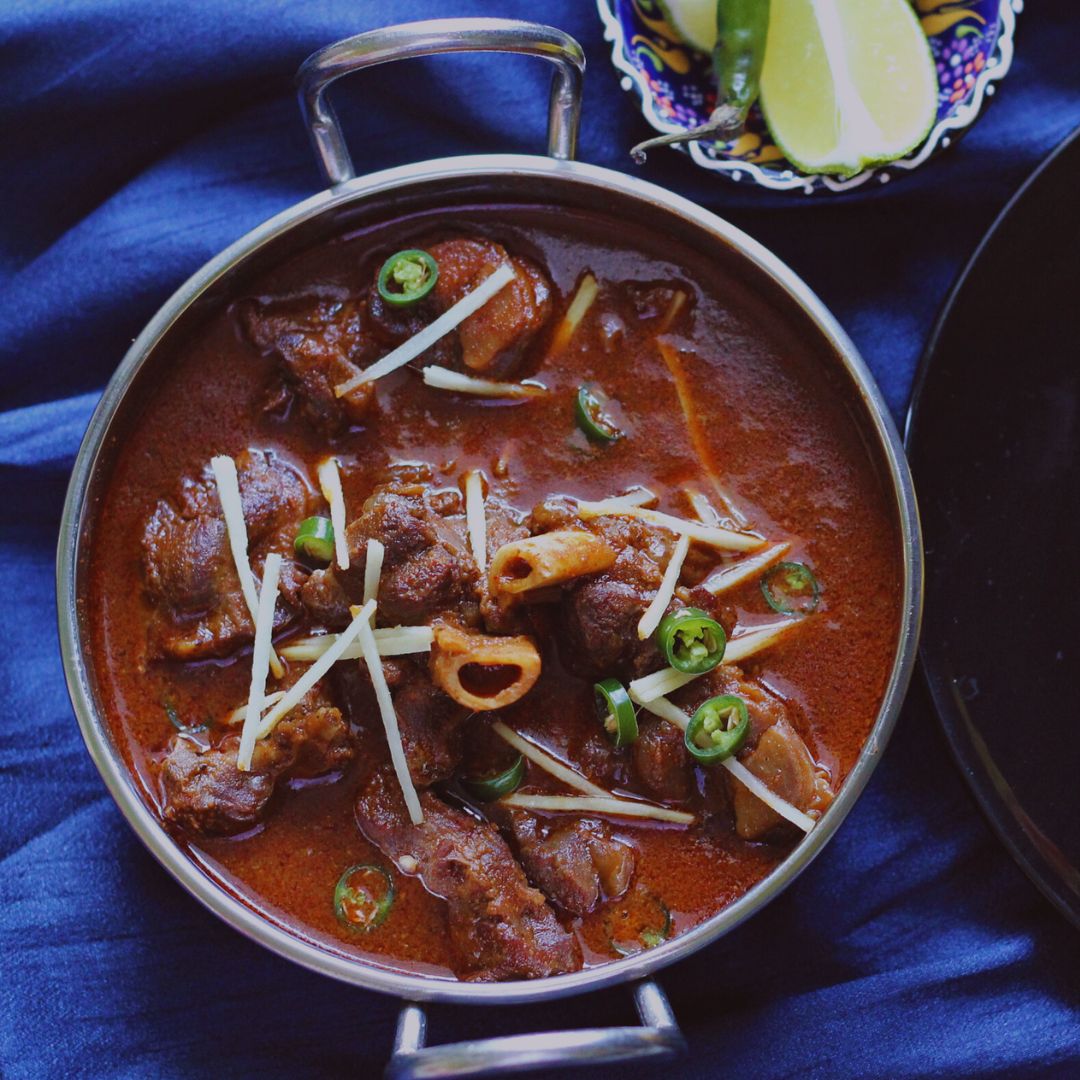In South Asian cuisine, nihari is a rich, flavorful, and aromatic dish that is especially popular in Indian and Pakistani homes. Nihari, a slow-cooked stew with tender meat, spices, and a rich gravy that dates back to the Mughal era, is frequently served as a substantial breakfast or a special occasion meal. This is a comprehensive, step-by-step recipe for making real Nihari at home.

Nihari Ingredients
| Meat and Gravy | Nihari Spice Mix | Garnishing |
|---|---|---|
| Meat (Beef or Mutton) -1 kg (with bones for extra flavor) | Fennel Seeds (Saunf) – 1 tsp | Fresh Coriander Leaves (chopped)– 1/2 cup |
| Wheat Flour (or Nihari Flour) – 3-4 tbsp | Coriander Seeds – 2 tsp | Ginger (julienned)– 2 tbsp |
| Ginger-Garlic Paste – 2 tbsp | Cumin Seeds -1 tsp | Green Chilies (sliced) – 2-3 |
| Onions (thinly sliced) – 2 medium | Cloves – 5-6 | Lemon Wedges– As needed |
| Yogurt (whisked) – 1 cup | Cinnamon Stick – 1 small piece | |
| Cooking Oil or Ghee -1/2 cup | Green Cardamom – 4-5 pods | |
| Black Cardamom – 1 pod | ||
| Bay Leaf – 1 | ||
| Nutmeg (grated) – A pinch | ||
| Mace – A small piece | ||
| Red Chili Powder – 1-2 tsp (adjust to taste) | ||
| Turmeric Powder – 1 tsp | ||
| Salt – To taste |

Bone marrow (Nalli) is optional but gives the dish more depth.
Buff Nihari
Preparation – Nihari Spice Mix
– In a pan, dry roast the cardamom pods, cloves, cinnamon, mace, nutmeg, cumin, coriander, and fennel seeds until fragrant.
– Using a mortar and pestle or a spice grinder, grind the roasted spices into a fine powder. The Nihari’s soul is formed by this homemade spice blend.

Nihari Recipe
Cooking the Nihari – Browning the Onions
– In a large pot, heat the oil or ghee over medium heat.
– Add the onions and cook until they are golden brown. Half of the fried onions should be taken out and reserved for garnish.
Sauteing the Meat –
– To the remaining onions in the pot, add the ginger-garlic paste and cook for one minute.
– Cook the meat (and bone marrow, if using) until it releases its juices and changes color.
– Add the red chili powder, turmeric powder, salt, and the prepared spice mix. To coat the meat, thoroughly mix.
Adding Yogurt –
– Reduce the heat and mix the meat with the whisked yogurt. Keep stirring to avoid curdling. Cook until the oil begins to separate from the mixture, a sign that the yogurt and spices are cooked through.

The Slow-Cooking Process
Simmering the Nihari –
– Add four to five cups of water to the pot, enough to completely submerge the meat. Heat it until it boils.
– Cover the pot, lower the heat to low, and simmer the Nihari for four to five hours. The meat becomes tender and the flavors blend harmoniously thanks to the slow cooking.
– To make sure the meat doesn’t sink to the bottom, periodically check the pot and stir.
Thickening the Gravy –
– Make a smooth slurry by combining water and wheat flour in a small bowl.
– To avoid lumps, add the slurry to the pot gradually while stirring continuously.
– The gravy should thicken to your preferred consistency after another half hour of cooking the Nihari.

Tips for the Perfect Nihari
– Pick the Correct Meat, Using meat that has bones, such as marrow, knuckle, or shank bones, gives the flavor more depth and complexity.
– Slow Cooking is Essential, Hours of slow cooking give Nihari its distinct flavor and texture. Do not hurry the process.
– Homemade Spice Mix, Although purchasing Nihari masala from the store is practical, creating your own blend guarantees authenticity and freshness.
– Bone Marrow, To improve the dish’s flavor and give it a smooth texture, use bone marrow (nalli) if it’s available.
– Wheat Flour Substitute, To thicken the gravy and make it gluten-free, use rice flour or cornflour.

Variations of Nihari
Chicken Nihari – This lighter and faster option is made in a similar manner but takes only one to two hours to cook.
Vegetarian Nihari – Use hearty vegetables like potatoes and carrots, jackfruit, or mushrooms in place of meat. To achieve a well-balanced flavor, adjust the spice mixture.
Hyderabadi Nihari – For a tangy twist, this version uses tamarind pulp.

Conclusion –
A classic treat that has endured through the ages, nihari is cherished for its nuanced flavors and substantial appeal. The outcome is definitely worth the effort, even though the cooking process may appear complex. It is a dish that unites people and makes an impression on the palate, whether you’re making it for a festive occasion or a comfortable family dinner.

You can enjoy the flavor of South Asian cuisine and recreate the enchantment of real Nihari in your kitchen with this recipe. Enjoy your meal.

